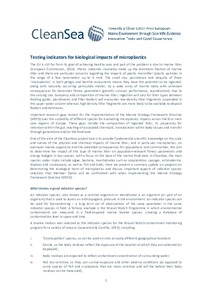| dc.coverage.spatial | European Seas | en_US |
| dc.date.accessioned | 2018-12-28T15:12:53Z | |
| dc.date.available | 2018-12-28T15:12:53Z | |
| dc.date.issued | 2016 | |
| dc.identifier.citation | CleanSea Project (2016) Testing indicators for biological impacts of microplastics. Amsterdam, Netherlands, VU University, Institute for Environmental Studies, 5pp. (D2_2factsheet). DOI: http://dx.doi.org/10.25607/OBP-173 | en_US |
| dc.identifier.other | D2_2factsheet | |
| dc.identifier.uri | http://hdl.handle.net/11329/610 | |
| dc.identifier.uri | http://dx.doi.org/10.25607/OBP-173 | |
| dc.description.abstract | The EU is still far from its goal of achieving healthy seas and part of the problem is due to marine litter
(European Commission, 2014). Plastic materials invariably make up the dominant fraction of marine
litter and there are particular concerns regarding the impacts of plastic microlitter (plastic particles in
the range of a few nanometers up to 5 mm). The small size, persistence and ubiquity of these
‘microplastics’ in both pelagic and benthic ecosystems means they have the potential to be ingested,
along with naturally occurring particulate matter, by a wide array of marine biota with unknown
consequences for Darwinian fitness parameters (growth, survival, performance, reproduction). Due to
the varying size, buoyancy and composition of marine litter, ingestion will vary for litter types between
feeding guilds; planktivores and filter feeders will encounter low-density litter fragments suspended in
the upper water column whereas high density litter fragments are more likely to be available to deposit
feeders and detrivores.
Important research gaps remain for the implementation of the Marine Strategy Framework Directive
(MSFD) over the suitability of different species for evaluating microplastics impacts across the four main
seas regions of Europe. These gaps include the composition of ingested litter, its propensity for
retention within the gut, leaching of associated chemicals, translocation within body tissues and transfer
through generations and/or the food web.
One of the aims of the CleanSea project task is to provide fundamental scientific knowledge on the scale
and nature of the physical and chemical impacts of marine litter, and in particular microplastics, on
exemplar marine organisms and the predicted consequences for populations and communities. We aim
to determine the impact of this type of marine litter on population-relevant fitness parameters and
energy budgets in key species, with a focus on the base of the marine food web. In CleanSea, the main
species under study include algae, bacteria, invertebrates such as zooplankton, sponges, echinoderms,
bivalves and crustaceans, as well as fish and birds. Here we present a summary update on progress on
determining the ecological harm of microplastics and discuss important aspects of indicator species
selection that Member States will be confronted with when implementing the Marine Strategy
Framework Directive (MSFD) | en_US |
| dc.language.iso | en | en_US |
| dc.publisher | VU University, Institute for Environmental Studies | en_US |
| dc.subject.other | MSFD | en_US |
| dc.subject.other | Marine litter | en_US |
| dc.subject.other | Plastics | en_US |
| dc.subject.other | Microplastics | en_US |
| dc.subject.other | Biological indicators | en_US |
| dc.subject.other | Hydrobiological indicators | en_US |
| dc.title | Testing indicators for biological impacts of microplastics . | en_US |
| dc.type | Report | en_US |
| dc.description.status | Published | en_US |
| dc.format.pages | 5pp. | en_US |
| dc.contributor.corpauthor | CleanSea Project | en_US |
| dc.description.refereed | Refereed | en_US |
| dc.publisher.place | Amsterdam, Netherlands | en_US |
| dc.subject.parameterDiscipline | Parameter Discipline::Environment::Anthropogenic contamination | en_US |
| dc.description.currentstatus | Current | en_US |
| dc.description.sdg | 14.A | en_US |
| dc.description.sdg | 14.1 | en_US |
| dc.description.eov | Zooplankton biomass and diversity | |
| dc.description.eov | Macroalgal canopy cover and composition | |
| dc.description.eov | Fish abundance and distribution | |
| dc.description.eov | Microbe biomass and diversity | |
| dc.description.bptype | Best Practice | en_US |
| dc.description.bptype | Guide | en_US |
| obps.contact.contactemail | heather.leslie@vu.nl | |
| obps.resourceurl.publisher | http://www.cleansea-project.eu/drupal/sites/default/files/project%20results/D2_2_factsheet.pdf | en_US |
 Repository of community practices in Ocean Research, Applications and Data/Information Management
Repository of community practices in Ocean Research, Applications and Data/Information Management
